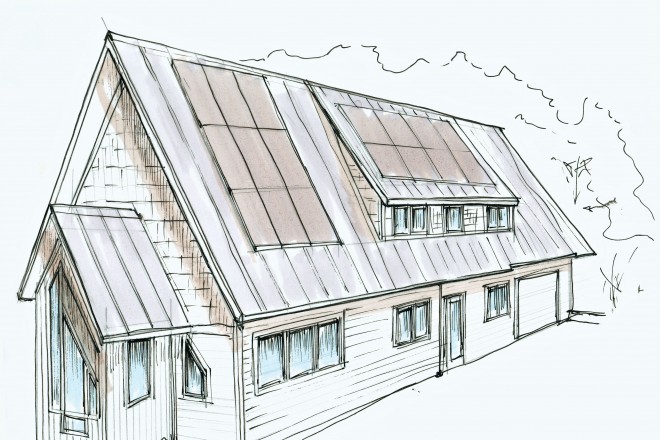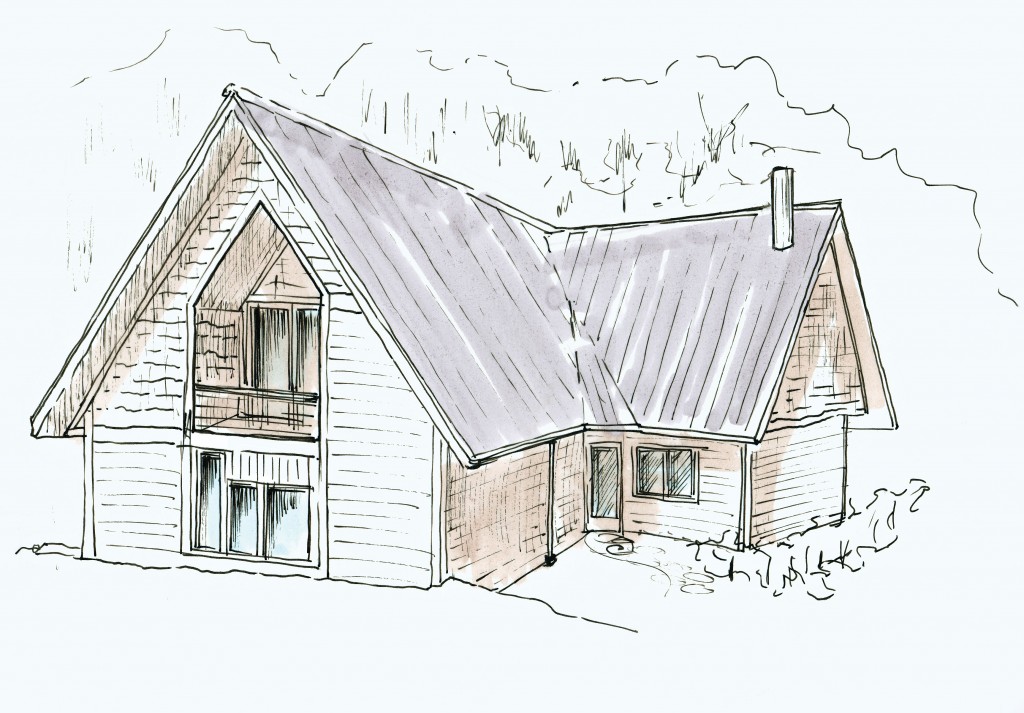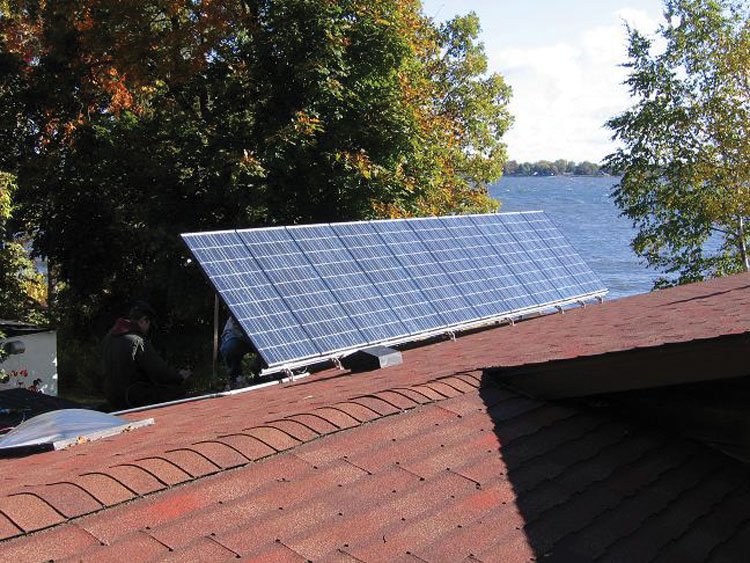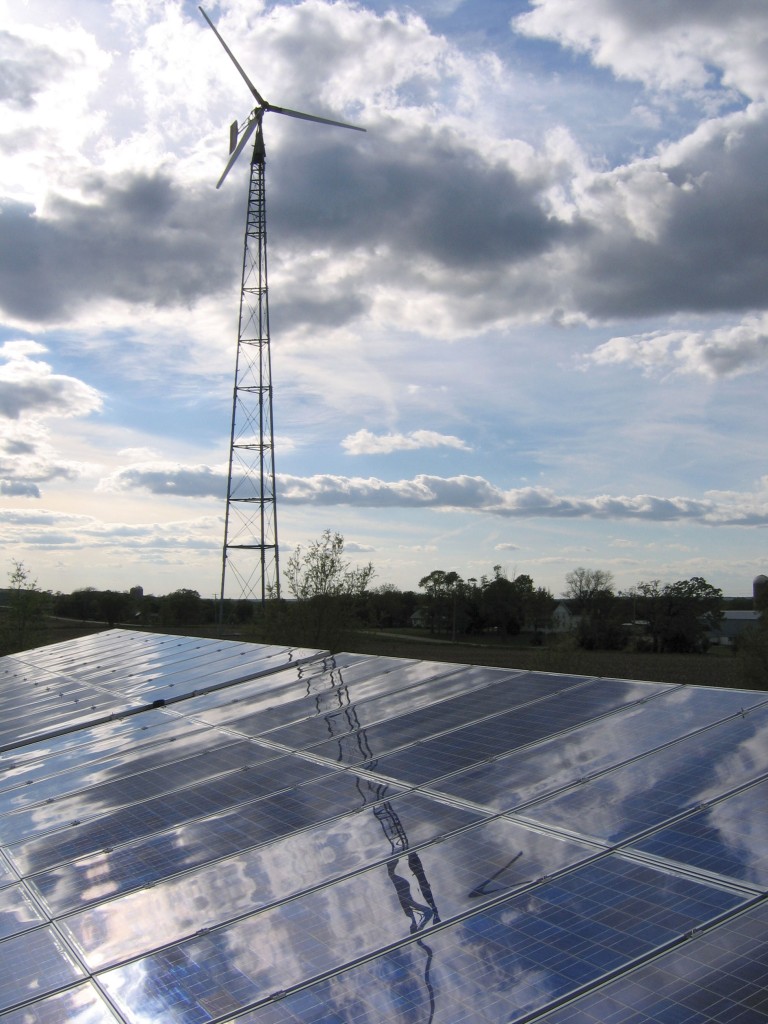Sustainable Homes
- Share
- Tweet
- Pin
- Share

Green. Sustainable. And the seemingly ubiquitous “reduce, re-use, recycle” mantra. What exactly do these words mean, particularly when describing a home?
Local licensed architect Virge Temme, designing sustainable buildings since 1992, quickly clears up one source of confusion: “green” and “sustainable” are interchangeable terms. She goes on to explain that “green architecture is a well-reasoned and long-seasoned approach to constructing homes and other buildings in a manner that, at best, enhances our built environment and, at least, causes less damage to our environment than standard practices. Green architecture is a blending of three components: design, materials, and systems.” A sustainable building uses green materials and building processes, that, over the life of the materials – collection, processing, installation, and eventual disposal and replacement – endanger or affect the environment as little as possible.
Virge notes many people are initially resistant to considering a green home, perhaps imagining the architecture looking like some sort of bad 1970s-style commune. “Resistance is easily overcome, though,” she says, “once they learn they’ll save money in the long run!” National studies have shown the initial cost of building a green home as two to five percent more than for a non-green home, while reputable certification may add up to another $3,000. However, over the expected 30-year life of a home’s materials and amenities, such as cabinets, furnace, roof, and appliances, a green home will save owners 10 to 30 percent in operating costs – possibly more, considering current trends in energy costs.

Guy Fortin and Judy Samida are currently having a green home constructed near Sturgeon Bay, which will be one of the first Leadership in Energy and Environmental Design (LEED) certified homes in the nation, and the first in Wisconsin (see sidebar on the LEED program). In planning their home, Guy and Judy followed the two main rules forming the basis of green construction: 1) build no larger than needed and 2) insulate as well as possible. When describing how they chose to construct their new home, Judy notes she and Guy both have always been firm environmentalists, but they also like the idea of “the self-sufficiency, the independence of a green home that is as ‘off the grid’ as possible. My grandparents had their own garden, and generally didn’t rely on other people if they didn’t have to, so I grew up with these ideas. Also, we both, Guy especially, believe strongly in trying to maintain things yourselves and re-using and recycling things. You don’t go out and buy anything new if you don’t need to – it’s often just not necessary.”
Guy and Judy’s home will be 1,563 square feet, plus a 564 square-foot garage/workshop. This represents a 39 percent reduction in size from even their original modest plans, achieved primarily by taking spaces that initially had one designated use and redesigning them to multi-task. The overall construction footprint is also nearly 1,400 square feet smaller than the original plan, allowing more trees to be preserved. Judy explains that this “design process has been a lot of give and take! We knew we wanted a small house – that’s crucial, as it uses less product, etc. – but figuring out how to fit everything you really need into a small house is challenging. It’s much easier to go to the architect and just tell them all the rooms you want, with no size constraint. We had to do a lot of moving things around, rearranging, re-drawing of plans. But, it’s been worth it, as we’re going to have everything we’ve wanted. You just have to be really open-minded, flexible, and not in a huge hurry when designing your green home.”
Virtually all the materials being used to construct Guy and Judy’s home are from natural products that can be recycled at the end of their lifespan. Wood is being locally harvested using sustainable forestry practices. The foundation’s concrete slabs, in most homes typically covered with another layer of flooring, will themselves serve as the home’s floors. They will contain in-floor solar hydronic radiant heat and be finished with natural waxes and stains, the final product as smooth and beautiful as tile. A masonry wood stove will act as a supplementary heating source. The metal roof, already 80 percent recycled material to start, can be recycled when it needs to be replaced, and will act as a rainwater collection system. That system, which ensures the home will have a low impact on the groundwater aquifer, will supply all water for non-potable use in the home and yard, and possibly drinking water, too, when codes permit. Low-flow toilets and other water fixtures are being installed, and energy-efficient appliances. For power, the home will rely on solar photovoltaic panels.
During the actual construction process, there will be no dumpsters on the property, strict recycling practices for both worker waste and construction materials, and no extra trees cut. Other than the construction site, the only trees to be removed are those growing within 80 feet of the house’s south side. In that cleared area, necessary for the solar panels to function, the septic field and vegetable gardens will be located. Water for the garden and the woodland restoration efforts and native plantings will come from the roof’s rainwater collection system.
Judy notes that, while they have made the best choices they can, “there is no perfect solution, in building a home or otherwise. You just need to be informed about what you’re doing, and make the best choices you can. This is true for everything from making sure you recycle, to paying attention when you purchase things. How is the item packaged? Where did it come from? Do I really need it? It’s just incredible the things you need to think about and decide when you try and implement a green philosophy.”
If you’re like me, after learning about Guy and Judy’s home, you’re depressed: you consider yourself environmentally conscious and responsible, but the house you built or bought doesn’t do or have any of these features. What can you do? First, Virge admonishes, “Don’t throw out things that are still working just for the sake of replacing them with like ‘green’ items! Part of being ‘green’ is adding as little as possible to landfills.” There are some things you can do right away, though, to begin moving your home toward sustainability.

Have your furnace and hot water heater efficiency levels checked. If poor, it probably makes long-run financial sense to replace them now. And, even if your water heater’s efficiency is acceptable, install a timer on it rather than running it 24/7. Finally, when you do need a new hot water heater, consider an on-demand water heating system, which kicks in only when needed.
If you have an old home, you may want to replace the insulation, particularly in easily accessible areas such as the attic. Replacing attic insulation with icynene, a “green” open-cell insulation that can be sprayed in, can help you use up to 30 percent less energy heating your home.
Interested in moving your power supply toward self-sufficiency? Contact Wisconsin Focus on Energy about the rebates they provide (covering about half the cost) for solar water panel installation.
Time for new lightbulbs? Purchase compact fluorescent lightbulbs – you’ll see a 25-30 percent energy savings. Need new carpets? Carpet made with recycled materials is now available. Painting something? Buy a low VOC (volatile organic compound) paint, which decreases the “outgassing” occurring from most paints. Remodeling a kitchen or replacing appliances? Purchase energy-efficient appliances, and look for countertops made with no petroleum products.
Finally, try whenever possible to use sustainably processed, local materials. In addition to conserving the fuel that would be used to transport the materials, you’ll be supporting the local economy.
The LEED for Homes Program
In 2000, the U.S. Green Building Council (USGBC) established the Leadership in Energy and Environmental Design (LEED) program for commercial buildings, evaluating materials and technologies on a variety of environmental standards. LEED for Homes is the newest of the LEED programs, and will be released for use in February 2007.
The LEED rating system awards points for site work, construction practices, and materials used, as well as energy systems, landscaping, and construction waste reduction and management. The current LEED for Homes Checklist, available at www.USGBC.org/LEED/homes, identifies the rating system’s 87 point-earning items.
Green Certifications
As you pursue your sustainable building, beware of “greenwashing,” defined as “disinformation disseminated by an organization so as to present an environmentally responsible public image.” For example, one major national organization offering green building certifications was founded by organizations with an economic interest in non-green building practices. Your best bet is to educate yourself, both about green materials and practices generally and your potential architect/builder’s specifically. Start off by exploring the Natural Choice Directory, an on-line green building source for architects and contractors; the Whole Building Design Guide, a guide to sustainable building products; and the Midwest Renewable Energy Association, providing a variety of information and resources regarding green building practices.

Size Matters
Average home in the U.S., 1950: 983 square feet.
Average home in the U.S., 2005: 2,412 square feet.
Average U.S. household size, 1950: 3.25 people.
Average U.S. household size, 2005: 2.5 people.
Today’s average home, therefore, has 300 percent more space per person than fifty years ago.
Houses that are larger consume more of everything: lumber, concrete, shingles, flooring, drywall, trim, and even furnishings, not to mention the added fuel required for heating and cooling a conventionally constructed home.
Experts believe 80 percent of greenhouse gases come directly from the built environment, with houses contributing 80 percent of that amount.
On average, 8,000 pounds of waste is taken to the landfills from each 2,400 square-foot conventionally constructed home.
All told, houses are considered to have a larger impact on our environment than any other single source. The larger the house, the larger the impact.


